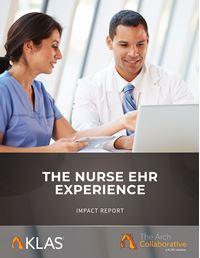The Nurse EHR Experience
An Arch Collaborative Impact Report 2019
Since nurses work widely with the EHR, it is crucial to measure their experience with it so that opportunities for improvement can be found. And since, on average, nurses report significantly higher EHR satisfaction than physicians, it is also important to understand their successes; doing so provides vital information about how to improve EHR satisfaction for all clinicians.
Want to see full details?
Want to see full details?
Here is my information:


While nurses are more satisfied than physicians in every category measured by the Arch Collaborative EHR satisfaction survey, some of the strongest satisfaction points for nurses are those related to patient care. The majority of the care-delivery support that occurs in the EHR is completed by nurses. While this time spent in the EHR reduces the amount of time nurses have to spend on direct patient care, nurses still spend more time with patients than physicians do, and Arch Collaborative data shows that the majority of nurses agree that the EHR benefits patients.
1 Some estimate that 75% of chart use can be attributed to nurses.
2 Linda W. Higgins et al., “Hospital Nurses’ Work Activity in a Technology-Rich Environment: A Triangulated Quality Improvement Assessment,” Journal of Nursing Care Quality 32, no. 3 (July/September 2017): 208–17, https://journals.lww.com/jncqjournal/Fulltext/2017/07000/Hospital_Nurses
__Work_Activity_in_a.6.aspx.

Despite the successes highlighted above, a large percentage of nurses report pain points in other, equally important metrics. Regardless of a user’s clinical background, an EHR can be difficult to learn, and nurses generally report room for improvement when it comes to factors related to EHR usability.

Nursing leaders at many organizations tell KLAS that their departments are driven by a culture of teamwork and openness to adopting changes that will help them achieve better patient outcomes and patient safety. This anecdotal evidence is corroborated by Collaborative data. The EHR satisfaction survey asks participants to rate the performance of three groups of key EHR stakeholders: (1) the clinical end users, (2) the EHR vendor, and (3) the organization’s leadership and IT groups. Nurses rate themselves as the highest-performing group (and rate their leadership/IT groups the lowest). This indicates that nurses put the bulk of EHR-mastery responsibility on themselves.

When organizations discuss EHR issues—whether related to training, usability, governance, or change management—they must make sure they seek out the opinions of their nurses. At too many organizations, nurses have been left to utilize their own teams and peers to master the EHR. Organizations can increase EHR satisfaction among their nurses—and likely other clinicians too—by working to amplify the nurse voice in EHR matters.

Report Non-Public HTML Body
Report Public HTML Body
Topics
Report Topics
Nursing EHR Success, Onboarding EHR Education, Ongoing EHR Education, Shared Ownership and GovernanceThis material is copyrighted. Any organization gaining unauthorized access to this report will be liable to compensate KLAS for the full retail price. Please see the KLAS DATA USE POLICY for information regarding use of this report. © 2019 KLAS Research, LLC. All Rights Reserved. NOTE: Performance scores may change significantly when including newly interviewed provider organizations, especially when added to a smaller sample size like in emerging markets with a small number of live clients. The findings presented are not meant to be conclusive data for an entire client base.



